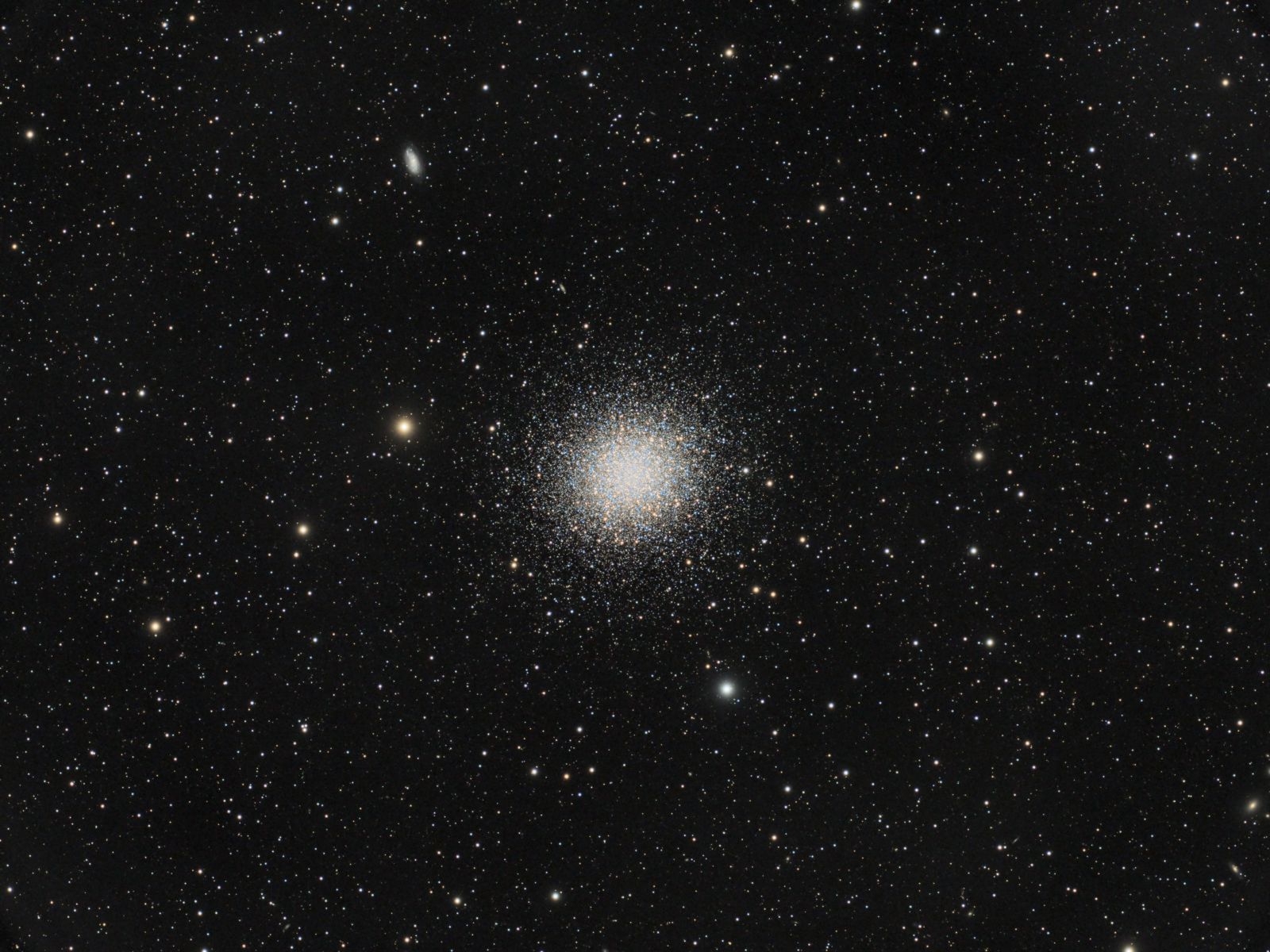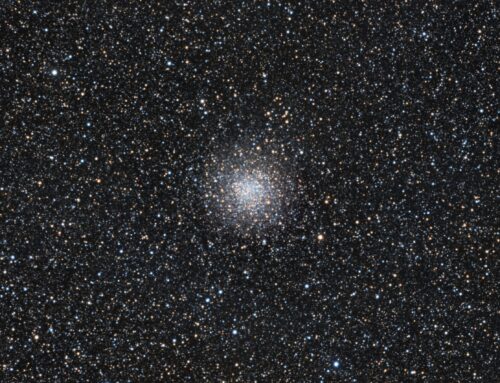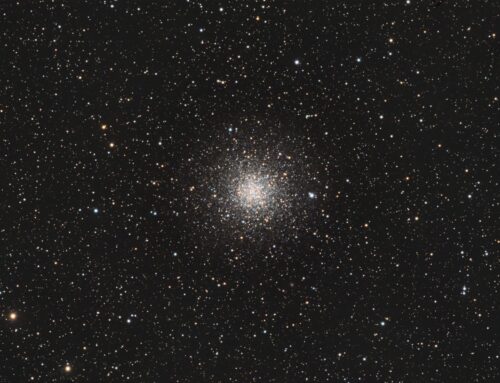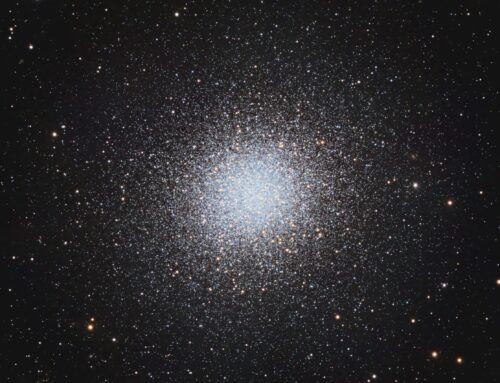M13, The Hercules Cluster
 Click image for full size version
Click image for full size version
June 7, 2021
There are about 150 globular clusters orbiting the main part of the Milky Way, and they are common around other galaxies too. These objects are star clusters of a few hundred thousand to a few million stars and they are very old objects. The Hercules Cluster, M13, is arguably the finest globular cluster visible from the northern hemisphere but lots of people, including me, have other favourites, like M5 and M22. M13 lies about 22,000 light years away from us, and is about 2/3 the width of the full Moon.It contains about 600,000 stars and is about 168 light years across. The night sky would be very interesting from a star in the core of that cluster!
M13 is visible to the naked eye in moderately dark skies, obvious in binoculars, pretty in a small scope and stunning in a big scope. It’s one of my favourite objects to look at through any instrument.
Sharing the limelight with the likes of M13 must be tough, but there are many faint galaxies in the distant background that are visible in this shot, including NGC 6207 at upper left.
This one of the first images made using my new QHY600M camera on my Sky-Watcher Esprit 150 f/7 refractor.
Tekkies:
Acquisition, focusing, and control of Paramount MX mount (unguided) with N.I.N.A. and TheSkyX. Focus with Optec DirectSync motor and controller. Equipment control with PrimaLuce Labs Eagle 4 Pro computer. All pre-processing and processing in PixInsight. Acquired from my SkyShed in Guelph. Average transparency and seeing. Data acquired May 8-13, 2021 in a moonless sky.
Luminance: Sky-Watcher Esprit 150 f/7 refractor and QHY600M camera with Optolong UV/IR filter
Chrominance: Takahashi FSQ-106 ED IV @ f/5 and QHY367C Pro one-shot colour camera with Optolong UV/IR filter
Luminance 35x5m = 2hr55m
Chrominance 226x1m = 3hr46m
Total: 7hr04m
Data Reduction and Initial Processing
Preprocessing: The WeightedBatchPreProcessing script was used to create two Luminance master frames from the mono camera and an RGB master frame from the one-shot colour camera. The RGB master was registered to the Luminance masters using StarAlignment.
Gradient Removal: DBE was applied to all three masters using Subtraction.
Colour
Colour Balancing: Colour was balanced with ColorCalibration.
Linear Noise Reduction: MultiscaleLinearTransform was used to reduce noise in the background areas, using an internal mask to protect bright structures. Layer settings for threshold and strength: Layer 1: 5.0 0.85, 2 iterations; Layer 2: 3.5, 0.75, 2 iterations.
Stretching: HistogramTransformation was applied to make a pleasing, bright image, with background set to an intensity of approximately 0.10.
Lightness
Combining short and long masters: HDRComposition was used to make a single master Lightness from the short and long masters.
Linear Noise Reduction: MultiscaleLinearTransform was used to reduce noise in the background areas, using an internal mask to protect bright stars. Layer settings for threshold and strength: Layer 1: 3.0 0.85, 1 iterations; Layer 2: 2.0, 0.75, 2 iterations.
Stretching: HistogramTransformation was applied to make a pleasing, bright image, with background set to an intensity of approximately 0.10.
Combining Lightness and Colour Images
LRGB Combination: The lightness image was applied to the RGB image using LRGBCombination with default settings.
Additional Processing
Compression: The core of M13 was compressed in a clone of the image and blended into the original at 35%.
Nonlinear Noise Reduction: TGVDenoise was used in L*a*b* mode to reduce noise with a mask used to target the background areas and protect the stars (max. 1,000 iterations and convergence selected for both lightness and chrominance).
Final Steps: Background and star brightness, contrast, and colour saturation were adjusted in several iterations using CurvesTransformation with masks as required. ICCProfileTransformation (sRGB IEC61966-2.1; Relative Colorimetric with black point compensation) was applied prior to saving in jpg format.






Love the golden stars.
Beautifully done, love the colour and resolution!!
Ron Bracher ,
Answer my Question ,
M-87 is a Globular Cluster , or
M-87 is a Galaxy .?
Galaxy
Very well done.
I just adore deep vario images like this
Ron, amazing work again, but what are the fuzzies at 9 and 5 o’clock? There are several similar objects here, are they foreground stars or background galaxies or?
Those are two brighter stars in the field, much closer than the cluster. But there are also galaxies throughout the field. They look quite different from the round stars, being either streaks or ovals, and softer edged than the stars.
Hi Ron, I have been a follower of your excellent work for a while. As a keen PixInsighter, I appreciate your workflow and processing info.
As a matter of interest, approximately how long do you spend processing an image?
Regards
John
Congrats Ron !!! Looks great .
Awesome 😎 image!!!